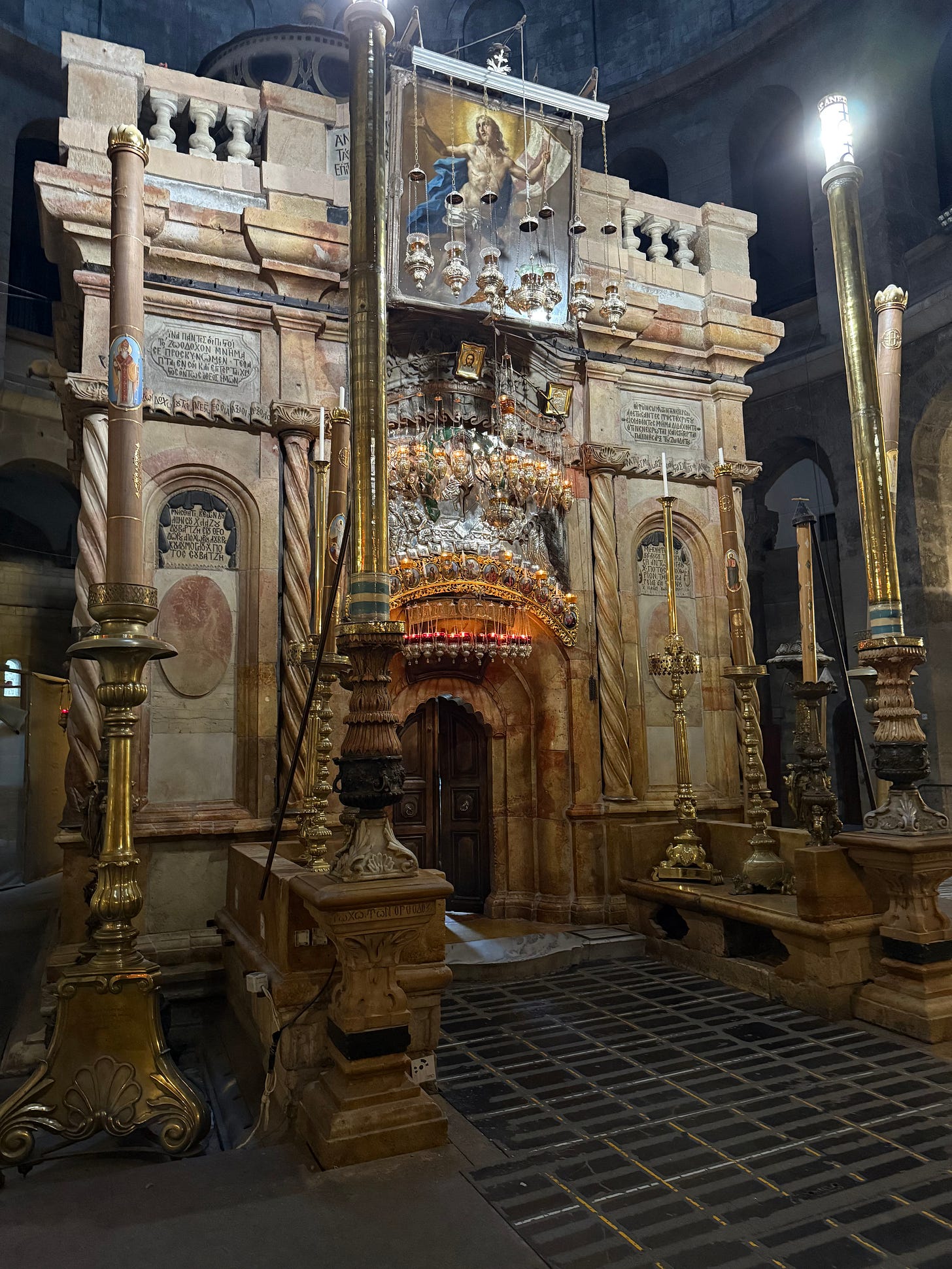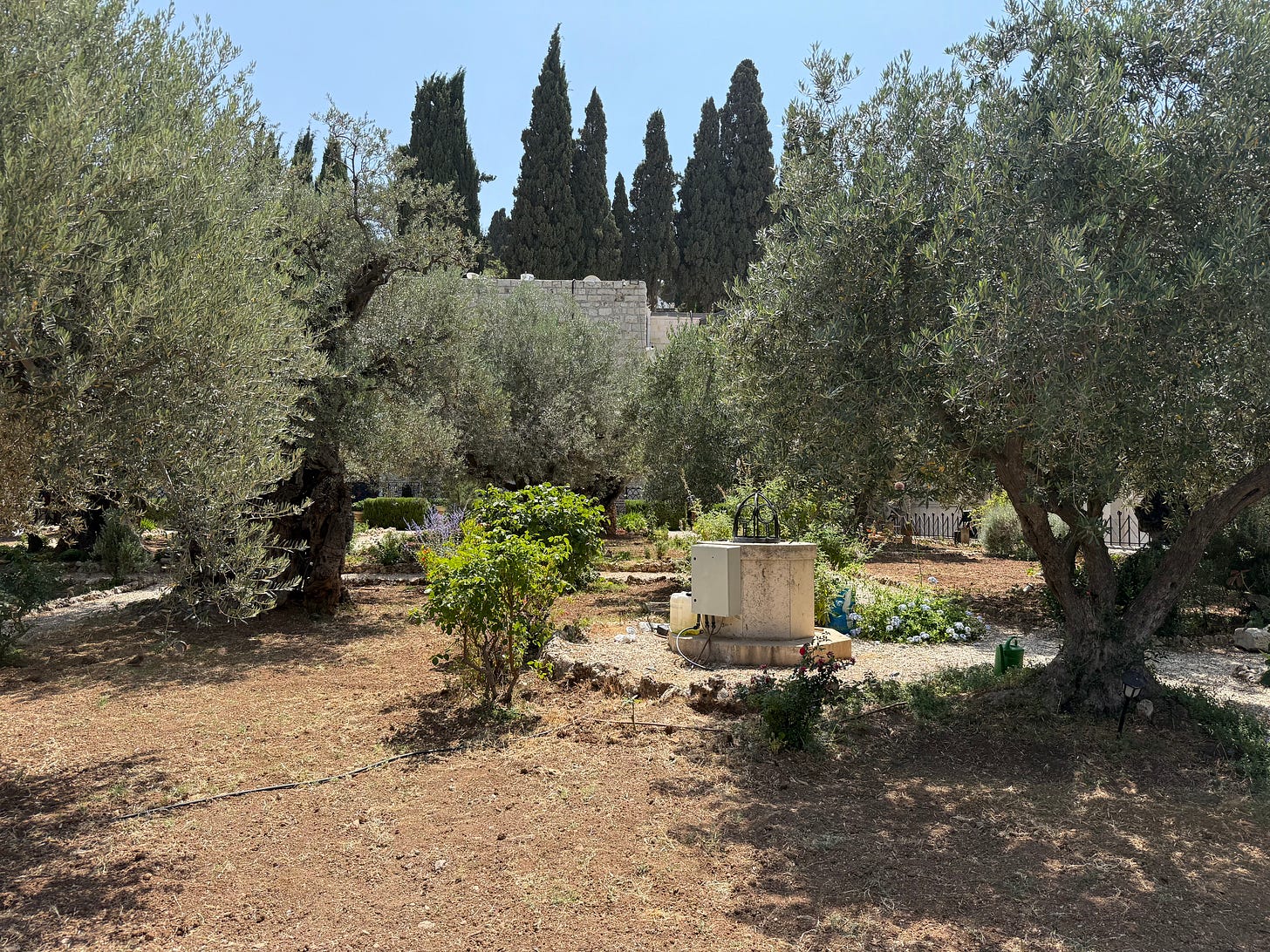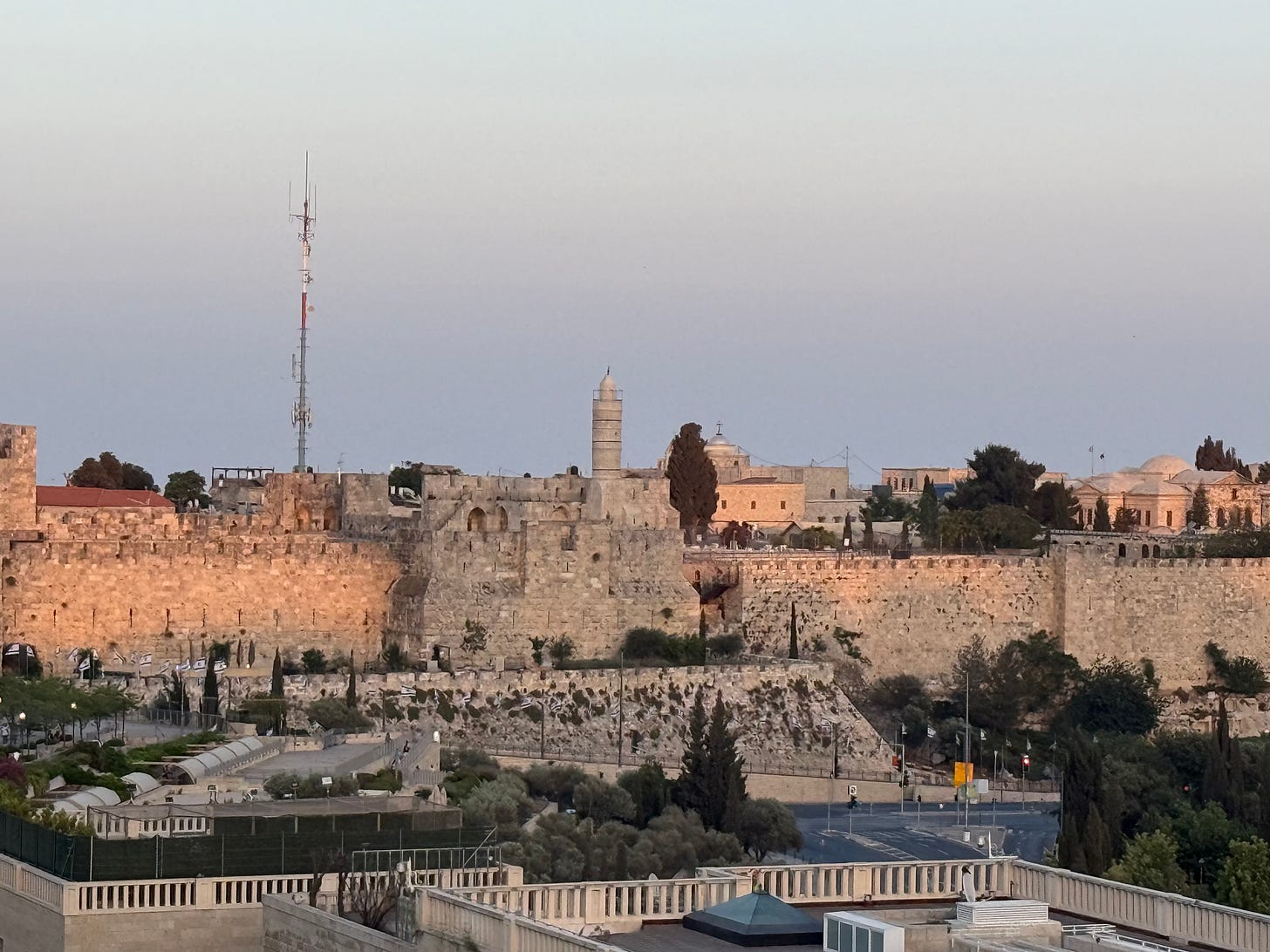As promised, I am sending a travelogue from Jerusalem, where I just spent most of the day in the Old City, primarily visiting Christian sites. (I also visited the graves of my grandmother and aunt, who are buried on a beautiful hillside here, overlooking a small valley.)
Our day started when I went with my husband and my friend Bill, who are both Catholic, to 6 AM mass inside Jesus’ tomb at the Church of the Holy Sepulcher. Tradition holds that Holy Sepulcher stands on the site where Jesus was both crucified and buried. You may know the place as Golgotha.
The tomb is inside a tiny chapel, which is inside the much larger church. Once a Franciscan monk shuts the doors to its antechamber as the mass begins, it becomes even smaller. I am not Catholic, or even Christian, but it was still incredibly moving to have experienced mass at dawn in a place that is so meaningful.
(The narrow doors leading to Jesus’ tomb inside the Church of the Holy Sepulcher. Once a monk shuts you and about ten others inside for the duration of the mass, it becomes even smaller.)
Later, we visited the Mount of Olives, the Garden of Gethsemane and all the stations of the cross along the Via Delarosa, before coming back to the Church of the Holy Sepulcher. Because it was Pentecost Sunday, we also went up to the Cenacle, the traditional site of the Last Supper and also the place where the Holy Spirit alighted upon the Apostles.
(The Garden of Gethsemane at the foot of the Mount of Olives, where the Gospels hold that Jesus underwent the Agony and was arrested.)
It doesn’t matter whether you belong to one of the three major religions that consider this the Holy Land or whether you worship differently or not at all. There is no other place in the world like it. Last night, as I was having a drink overlooking the view in the photo below, I could not stop thinking about how this tiny little plot of land has meant so much to so many for thousands of years. You don’t need to be religious to feel the weight of history in every cobblestone.
(The view of the Old City from West Jerusalem)
Despite what you may have read, the three religions here largely coexist in a city that should be much more of a daily tinderbox than it is, based on all that. As we were walking through the City of David this afternoon, which is an excavation site from the time of Kings David and Solomon outside the Old City walls, we heard the beautiful Muslim call to prayer coming over a loudspeaker from a minaret not far away. Sitting at a table next to us at dinner tonight were two Franciscan monks. When I asked my cousin, who is a doctor in Tel Aviv, whether he ever interacts with Palestinians (or Arabs, as they call them here), he looked at me like I had two heads and said: “Half the doctors in my hospital are Arabs. We go to each other’s weddings.”
Now to the situation in Israel since my last visit here seven years ago: this is a deeply divided country on many, many things but one absolutely united by shared grief around the events of October 7th. The first thing you see as you deplane, before even getting through customs, is photographs of the hostages lining the walls along the walkways at the airport. Nearly every car has a yellow ribbon tied to it to commemorate their captivity. The weight of that horrific day and its aftermath lies heavily upon everyone I spoke with, irrespective of political views. And those views are varied — about how this war is being prosecuted, about whether it is winnable and about what should happen next.
It reminded me of the days right after 9/11, where life went on but something felt as though it had irretrievably changed. In many ways, our huge nation has yet to recover from that trauma more than two decades later. Israel is a country the size of New Jersey, where everyone either knows at least one person who died or was taken hostage. For everyone here, this is very personal.
As a matter of straight reporting, I can tell you that we ran into young soldiers who, hearing our American accents, started chanting “Trump! Trump!” as they walked by. We spoke to others who said that Trump is losing support from Israelis by the day. We saw a banner that said “Make Gaza Jewish Again” but also heard from people who are horrified by the prosecution of this war and think that the sooner the military gets outs of Gaza, the better. I spoke to someone who is convinced that the downfall of the government here is imminent. Others said that the military has no choice but to finish the job in Gaza, although they could not quantify exactly what that meant.
In short, Israeli society is as polarized as our own. But the one thing that is absolutely clear is that the national trauma here runs very deep, which many Americans may not fully appreciate.
If you notice, I have not analyzed the political situation here on purpose, though it is not because I have not heard all about it, both from Israelis who supported the current government and those who never have. But I do want to spend the next week hearing from a larger subset of people before providing my perspective. The situation here is too complex for off-the-cuff analysis.
One final word about what is going on back home: I am convinced that Trump has sought opportunities to invoke the Insurrection Act and to suspend habeas corpus since his first term, when better people than the ones who surround him now prevented that from happening. By law, Congress has to allow him to suspend habeas, which even Abraham Lincoln eventually understood during the Civil War. We are not in a civil war and there is no national rebellion, although Trump is doing his best to rip us apart so that he can advance his own authoritarian agenda.
If you are in Los Angeles, please be careful. Everyone else, please stay vigilant. There are countries in the world that accepted an erosion of their liberties bit by bit, until their democracies were so stress-tested that what was once unthinkable became commonplace.
Our nation is in grave danger, indeed. More on that when I return. In the meantime, please indulge me in a little travel writing every so often while I am abroad, which I hope gives you a nice respite from the nightmare at home.
Stay safe. Stay Salty.
Julie








Julie, very good article. Particularly about how various cultures appear to be capable of peaceful and perhaps even friendly coexistence in Jerusalem. It contrasts with Mark Twain's humorous and purposefully cynical discussion of how the various Christian sects fought bitterly in that most holy of churches. (You mean, you didn't reread "Innocents Abroad" before your trip?!)
I also appreciate your obserrvation that, regardless of what individual Israelis feel about how the Gaza situation is being handled, everyone feels a deep sense of loss regarding the unprovoked and deadly October 7 massacre. It is important to remember that had the same proportion of Americans been killed on 9/11, the total would have been around 30,000; and with no hostages taken. As it was, the US invaded Afghanistan (45,000 civilian deaths) and Iraq (150,000 civilian deaths) as a result.
Actions have consequences (reactions). Newton says "equal and opposite," but that doesn't hold for human interactions!
Your article took me back to when my husband and I were there March 2023 with a group from my church. We were in all those places. Our tour guide was a Christian man who was Arabic by birth and living in Jerusalem. Fascinating viewpoints on his life there. When we went to Bethlehem- part of the West Bank- our bus passed through the guarded gates and barbed wire and we were boarded by an armed policeman. It was quick and nothing happened, but unnerving. This is just life there.
Was his bar mitzah at the Western Wall? We saw several going on while we were there.
Stay safe, Julie!